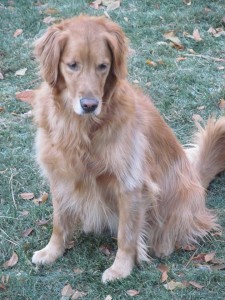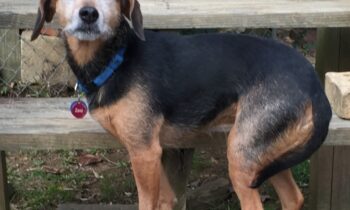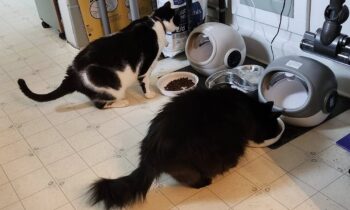
Dogs use calming signals—through body postures and facial expressions—to communicate with each other. Dogs tell other dogs, “I am no threat,” “I respect your space,” “I want to play!”
Dogs defuse volatile situations with each other. Dogs de-escalate sudden confrontations. Dogs instigate friendly interactions. Dogs instinctively react to other dogs’ calming signals. Instinct tells dogs that not fighting with each other is a much better strategy than fighting. Dogs’ survival depends on it.
Humans can use calming signals, too!
Observe dogs interacting with each other.
Watch how a variety of dogs introduce themselves to each other. Young dogs and young-at-heart dogs may fail to observe the proprieties. They might run into a group of other dogs with a carefree “everybody loves me” attitude. They invade the space of other dogs with no hesitation. Older dogs may respond with a growl, but often a wiser dog will simply walk away. In the dog world, a face-on confrontation at first meeting is not advisable. Dogs favor distance and time to make critical choices. “Am I safe?” is the first question. Dogs do not feel safe when the unknown is entering their space.
Dogs need first meetings s-l-o-w-e-d down.
Dogs have a lot of information to gather.
Dogs rely on sight, sound and, importantly, smell as they “profile” an unfamiliar dog who is “incoming” on their space. Dogs analyze the information they receive through all their senses based on instinct and their experience. Dogs can make decisions about the incoming dog quickly, but the quicker the decision, the less likely it is to be fully informed.
“Not safe” is the default. If there isn’t enough time to make an informed decision, dog instinct must choose “not safe.” It’s a matter of survival.

Slow Down
When you see a dog who is new to you, or a dog you haven’t seen recently, slow down. Stop where you are. Let the dog approach you. Don’t let yourself get stuck in a small space with the dog (you may be meeting at a front door, for example). If possible, allow the dog to approach you in the most open possible place—maybe on the front porch instead of in a small entryway.
Don’t freeze, but stand relatively still, in a relaxed posture.
Stand Sideways
When you come to a stop, stand sideways to the dog. Do not face the dog full-frontally.
Look Away
When you are standing sideways, observe the dog with your peripheral vision.
Yawn
When you yawn, you relax your face and you show the dog a familiar calming signal.
“Chew Gum”
You won’t need to “chew gum” literally—it’s the motion of your mouth!
Maintain your relaxed sideways stance—not frozen in place, but breathing calmly, knees flexed, hands at your sides, unfisted. Look down but keep the dog in the corner of your vision. Yawn, “chew gum,” and wait . . . patiently. Let the dog decide. If the dog approaches you, remain still.
Do Not Reach Out for the Dog
Dogs respond differently to human voices, depending in large part on their experiences. When you meet a new dog with an owner, the owner (especially if it’s a stranger) may well expect you to say something. While it would be impolite to the human to not speak at all, it may be the right thing for the dog! I suggest very quiet responses in a calm, unanimated tone of voice. You don’t, after all, want to remind a new dog of a yappy little mutt barking loudly and annoyingly! Instead, approach like a mature animal. Don’t let a laugh or sneeze surprise him if you can possibly avoid it. I find that asking the owner the dog’s name can be a good introductory ploy. The dog hears its own name from its owner, then you repeat the name quietly.
Let the Dog Sniff You
- Hold your arms down at your side, hands open (no fist). The dog may first sniff your shoes and pants, especially if you have animals of your own at home. It may take a while if you have many pets!
- The dog may decide to stick around or the dog may “check in” with its owner, either by looking at or by running back to him or her. You should remain relaxed, standing sideways, in the same place.
- Don’t move if the dog sniffs your hand.
Don’t assume that the dog’s sniffing your hand means you are now friends. Don’t walk into that crowded space inside the front door. Don’t think that your “application for friendship and trust” has been accepted.
Sniffing your hand indicates a level of trust, certainly—the dog is trusting that you are safe to sniff. To be accepted on the porch or in the park is only level one. Don’t blow it by assuming that you are done with introductions. Instead, leave it on a high note, with a success. Don’t push the process!
Walk Away From the Dog
You end the interaction. Don’t wait until the dog has had enough. Always leave the dog wanting more! As you leave, you may out of the corner of your eye see the dog attempt to follow you. This is a good sign . . . unless, of course, the dog is lunging to chase you away! Ideally, the owner should be praising and rewarding the dog to direct the dog’s attention back to him or herself.
You can use these simple calming signals every time you interact with any dog! For example, with your own dog, it’s often wise to stand sideways when you are calling the dog to come to you, especially if there might be a good reason for the dog to consider not coming to you. Be as non-threatening as possible when it’s most important that he return to you. This is especially true in “panic” situations, where a dog has escaped a fenced yard and is running toward traffic, for example.
You can communicate so much to your own dog—and to every dog you meet—by incorporating calming signals into your own human behavior. Once you’ve learned the simple basics, you will be rewarded by your own dog and by dogs you meet (on purpose and by accident). Knowing the basics will also give you insight into how dogs interact with other dogs, and how dogs interact with other humans!
For more information on calming signals in dogs, Google “Turid Rugaas”+Norway



